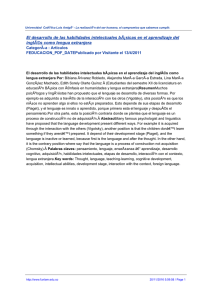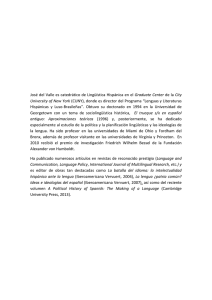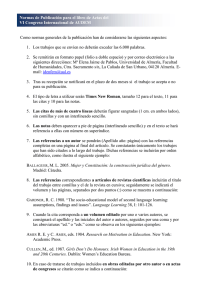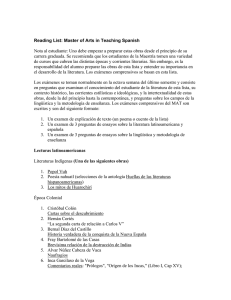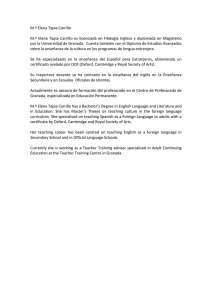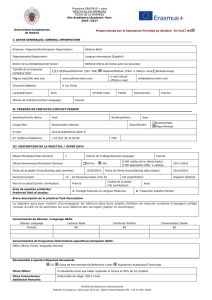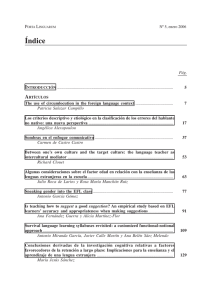Page 1 of 6 - Kansas State University
Anuncio
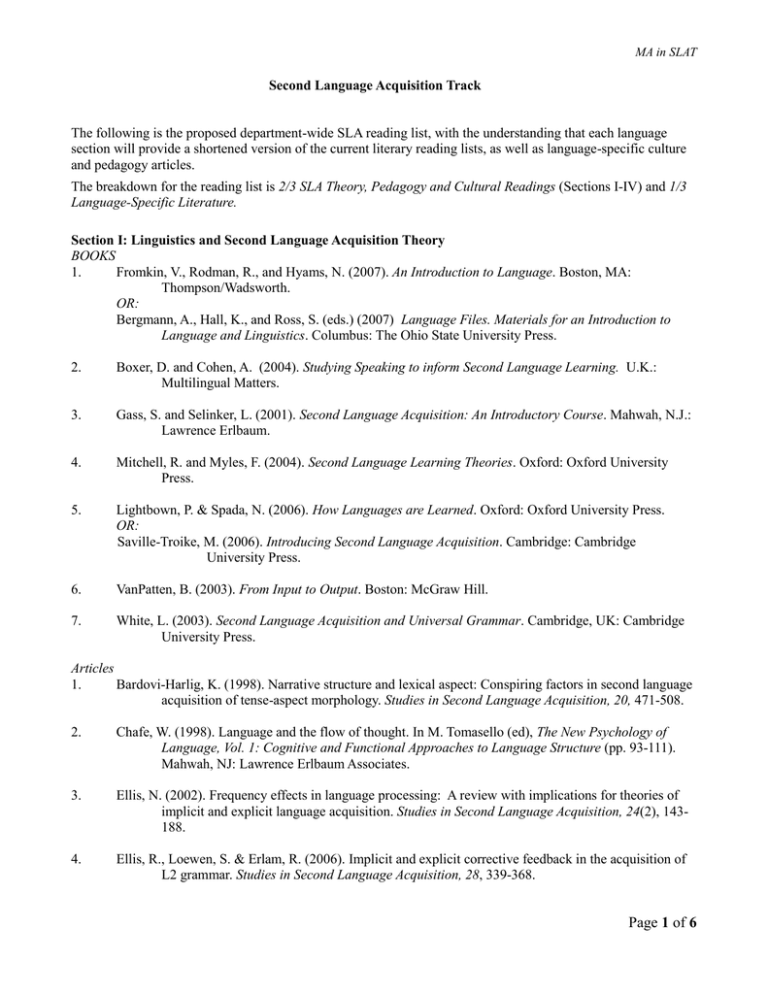
MA in SLAT Second Language Acquisition Track The following is the proposed department-wide SLA reading list, with the understanding that each language section will provide a shortened version of the current literary reading lists, as well as language-specific culture and pedagogy articles. The breakdown for the reading list is 2/3 SLA Theory, Pedagogy and Cultural Readings (Sections I-IV) and 1/3 Language-Specific Literature. Section I: Linguistics and Second Language Acquisition Theory BOOKS 1. Fromkin, V., Rodman, R., and Hyams, N. (2007). An Introduction to Language. Boston, MA: Thompson/Wadsworth. OR: Bergmann, A., Hall, K., and Ross, S. (eds.) (2007) Language Files. Materials for an Introduction to Language and Linguistics. Columbus: The Ohio State University Press. 2. Boxer, D. and Cohen, A. (2004). Studying Speaking to inform Second Language Learning. U.K.: Multilingual Matters. 3. Gass, S. and Selinker, L. (2001). Second Language Acquisition: An Introductory Course. Mahwah, N.J.: Lawrence Erlbaum. 4. Mitchell, R. and Myles, F. (2004). Second Language Learning Theories. Oxford: Oxford University Press. 5. Lightbown, P. & Spada, N. (2006). How Languages are Learned. Oxford: Oxford University Press. OR: Saville-Troike, M. (2006). Introducing Second Language Acquisition. Cambridge: Cambridge University Press. 6. VanPatten, B. (2003). From Input to Output. Boston: McGraw Hill. 7. White, L. (2003). Second Language Acquisition and Universal Grammar. Cambridge, UK: Cambridge University Press. Articles 1. Bardovi-Harlig, K. (1998). Narrative structure and lexical aspect: Conspiring factors in second language acquisition of tense-aspect morphology. Studies in Second Language Acquisition, 20, 471-508. 2. Chafe, W. (1998). Language and the flow of thought. In M. Tomasello (ed), The New Psychology of Language, Vol. 1: Cognitive and Functional Approaches to Language Structure (pp. 93-111). Mahwah, NJ: Lawrence Erlbaum Associates. 3. Ellis, N. (2002). Frequency effects in language processing: A review with implications for theories of implicit and explicit language acquisition. Studies in Second Language Acquisition, 24(2), 143188. 4. Ellis, R., Loewen, S. & Erlam, R. (2006). Implicit and explicit corrective feedback in the acquisition of L2 grammar. Studies in Second Language Acquisition, 28, 339-368. Page 1 of 6 MA in SLAT 5. Fox, B. (2007). Principles shaping grammatical practices: an exploration. Discourse Studies, 9, 299-318. AND/OR: Ford, C., Fox, B., & Thompson, S. A. (2003). Social interaction and grammar. In M. Tomasello (Ed.), The New Psychology of Language, Vol. 2 (pp. 119-143). Mahwah N.J.: Lawrence Erlbaum. 6. Hopper, P. (1998). Emergent grammar. In M. Tomasello (ed), The New Psychology of Language, Vol. 1: Cognitive and Functional Approaches to Language Structure (pp. 155-175). Mahwah, NJ: Lawrence Erlbaum Associates. 7. Levinson, S.C. (2006). On the human "interactional engine". In N. Enfield & S.C. Levinson (eds.) Roots of Human Sociality (pp. 39-69). Oxford: Berg Publishers. 8. Long, M. H. (1990). The least a second language acquisition theory needs to explain. Tesol Quarterly, 24.4: 649-666. Reprinted in: Brown, H. D., & Gonzo, S. (eds.) (1994). Readings on second language acquisition (pp. 470-90). Englewood-Cliffs, NJ: Prentice Hall Regents. Section II: Second Language Research Design 1. Mackey, A. and Gass, S. (2005). Second Language Research: Methodology and Design. Mahwah, NJ: Lawrence Erlbaum Associates. OR: Field, A. and Hole, G. (2003). How to Design and Report Experiments. London: Sage Publications. 2. Golato, A. (2003). Studying compliment responses: A comparison of DCTs and recordings of naturally occurring talk. Applied Linguistics, 24(1), 90-121. Section III: Second Language Pedagogy/Methods and Professional Development Books 1. Lee, J.F. and VanPatten, B. (2003). Making Communicative Language Teaching Happen. Boston: McGraw Hill. OR: Brandl, K. (2008). Communicative Language Teaching in Action: Putting Principles to Work. Upper Saddle River, N.J.: Pearson Prentice Hall. 2. Omaggio-Hadley, A. (2003). Teaching Language in Context. Boston: Heinle & Heinle. 3. Richards, J. and Rodgers, T. (2001). Approaches and Methods in Language Teaching. New York: Cambridge University Press. 4. Savignon, S.J. (1997). Communicative Competence: Theory and Classroom Practice. Boston: McGraw Hill. 5. Kumaravadivelu, B. (2003). Beyond methods: Macro-strategies for language teaching. New Haven and London: Yale University Press. Articles 1. Benson, D. (2002). Language acquisition, culture acquisition, literature acquisition: An integrated approach to beginning and intermediate language classes. 2002 Central States Conference Report, 73-91. 2. Berry-Bravo, J. (1993). Teaching the art of circumlocution. Hispania, 76, 371-77. Page 2 of 6 MA in SLAT 3. Fonder-Solano, L. and Burnett, J. (2004). Teaching literature/reading: A dialogue on professional Growth. Foreign Language Annals 37(3), 459-469. 4. Knutson, E. M. (1997). Reading with a purpose: Communicative reading tasks for the foreign language classroom. Foreign Language Annals 30(1), 49-57. 5. Paesani, K. (2005). Literary texts and grammar instruction: Revisiting the inductive presentation. Foreign Language Annals 38(1), 15-24. 6. Weist, V. D. (2004). Literature in lower-level courses: Making progress in both language and reading skills. Foreign Language Annals 37(2): 209-223. 7. Phakiti, A. (2006). Theoretical and pedagogical issues in ESL/EFL: Teaching of strategic reading. University of Sydney Papers in TESOL, 1, 19-50. 8. Shook, D. (1997). Identifying and overcoming possible mismatches in the beginning reader-literary text interaction. Hispania, 80, 234-243. + section-specific readings (articles) for the areas of Second Language Pedagogy/Methods or Professional Development Section IV: Language and Culture 1. Canagarajah, A. S. (2003). Resisting Linguistic Imperialism in English Teaching. : Oxford University Press. 2. Kramsch, C. (1996). Context and Culture in Language Teaching. Oxford: Oxford University Press. 3. Rogoff, B. (2003). The Cultural Nature of Human Development. Oxford: Oxford University Press. + section-specific readings (articles) for the area of Language and Culture. These can be anthropological, sociological, sociocultural, etc., depending on the student’s interests. NOTE: Sections III and/or IV may be supplemented with language-specific articles, as chosen by the committee in consultation with the student. This should be a maximum of four articles *total* (additions for Section III and IV combined) or one additional book. Section V: Literature (list to be determined by each section) See list for Spain and Latin America on next pages. A significantly shorter version than the current SLA list (1-1.5 pages), consisting of core list developed by section and 5-7 texts based on the student’s interests and coursework. Focus on readings appropriate for use in SLL List should include some critical analyses of the core texts. List should include texts from 500 level civilization and anthologies from literature survey courses. Page 3 of 6 MA in SLAT Second Language Acquisition Track Spanish Literature Medieval (11th to 15th Century) Note: It is recommended that selections be read from the collection “Odres nuevos” (Ediciones Castalia). Gonzalo de Berceo. De Milagros de Nuestra Señora: “Introducción” (entiéndase la del propio Berceo), “El clérigo embriagado”. Juan Manuel. El conde Lucanor: “Ejemplo del mancebo que casó con mujer brava”, “D. Illán y el Deán de Santiago” and “El cuervo y el raposo”. Poema de Mío Cid. Romances: (de Flor nueva de romances viejos) Romance de la jura de Sta. Gadea; de Gerineldo y la Infanta; de Fontefrida; de Dª. Alda; del Infante Arnaldos; del Prisionero; de Abenámar y el rey D. Juan. Jorge Manrique. “Coplas por la muerte de su padre”. Fernando de Rojas. La Celestina. Early Modern (16th and 17th Century) Garcilaso de la Vega. Sonetos X y XXIII, Canción V y Égloga I. Lazarillo de Tormes. Miguel de Cervantes. Don Quijote. Lope de Vega. Fuenteovejuna. Tirso de Molina. El burlador de Sevilla or el convidado de piedra. Pedro Calderón de la Barca. El gran teatro del mundo or El gran mercado del mundo (autos). San Juan de la Cruz. “Noche oscura” and “Llama de amor viva”. Luis de Góngora. Sonetos LXXXII y CLXVI; Letrilla “Hermana Marica”; Romance XXXII. Francisco de Quevedo: Sonetos “¡Ah de la vida!... ¿Nadie me responde?”; “Miré los muros de la patria mía”; “Retirado en la paz de estos desiertos”; “¡Ay Floralba! Soé que te... ¿Dirélo?”; “Cerrar podrá mis ojos la postrera”; “Érase un hombre a una nariz pegado”. Letrilla “Poderoso caballero es don dinero”. Fray Luis de León. “Noche serena” and “Vida retirada”. 18th and 19th Centuries Leandro Fernández de Moratín. El sí de las niñas. José de Espronceda. “Canción del pirata”. José Zorrilla. Don Juan Tenorio. Ángel Saavedra, Duque de Rivas. “Una antigualla de Sevilla” and “Un castellano leal” (romances históricos). Gustavo Adolfo Bécquer. Leyendas: "Los ojos verdes" and “La promesa”. Rimas II, IV, VII, X, XIII, XV, XXI, XXXIII, XXXVIII, XLI, XLII, LII, LIII, LVI, LXII, LXXIII. Page 4 of 6 MA in SLAT 20th Century Miguel de Unamuno. San Manuel Bueno, mártir. Antonio Machado. “Desgarrada la nube”, “Recuerdo infantil”, “Daba el reloj las doce”, “Las moscas”, “Fue una clara tarde”, “El limonero lánguido”, “Caminante, son tus huellas”, “Anoche cuando dormía”, “Campos de Soria I-IX” de Campos de Castilla. Juan Ramón Jiménez. Platero y yo. Federico García Lorca. La casa de Bernarda Alba y poemas: “Sorpresa”, “Casida del llanto”, “Romance de la luna, luna”, “Romance sonámbulo”, “Romance de la pena negra”, “Canción de jinete”, “Reyerta”, “Oda al rey de Harlem”. Pedro Salinas. “El alma tenías”, “No te veo, bien sé”, “Amada exacta”, “Nombre”, “¿Serás, amor?”, “Si te quiero”. Carmen Laforet. Nada y relatos breves: “El aguinaldo”, “Al colegio”, “Rosamunda”. Antonio Buero Vallejo. Historia de una escalera. Ana María Matute. “Los niños buenos”, “El árbol de oro”, “El mundelo”. Note: It is recommended that poetry selections be read from Poesía española del siglo XX, ed. Gustavo Correa. Suggested Histories of Spanish Literature to consult Gies, David Thatcher. The Cambridge History of Spanish Literature. Cambridge, UK ; New Cambridge University Press, 2004. York : Rico, Francisco. Historia y crítica de la literatura española. Barcelona : Editorial Crítica, c1980-c1992. 1. Edad Media - al cuidado de Alan Deyermond. 2. Siglos de Oro, Renacimiento - al cuidado de Francisco López Estrada. 3. Siglos de Oro, Barroco - al cuidado de Bruce W. Wardropper y otros. 4. Ilustración y Neoclasicismo - al cuidado de José Miguel Caso González. 5. Romanticismo y realismo - al cuidado de Iris M. Zavala. 6. Modernismo y 98 - al cuidado de José Carlos Mainer. 7. Época contemporánea, 1914-1939 - al cuidado de Víctor García de la Concha y otros. 8. Época contemporánea, 1939-1980 - al cuidado de Domingo Ynduráin. 9. Los nuevos nombres, 1975-1990 - al cuidado de Dario Villanueva y otros. Appendix: 1/1 Alan Deyermond 2/1 Francisco López Estrada 3/1 Aurora Egido 4/1 David T. Gies y Russell P. Sebold 5/1 Iris Zavala 7/1 Agustín Sánchez Vidal 8/1 Santos Sanz Villanueva Page 5 of 6 MA in SLAT Seventeen volumes are available. Second Language Acquisition Track Spanish-American Literature Sor Juana Inés de la Cruz. “Hombres necios”, “Rosa divina que en gentil cultura”, “Detente sombra de mi bien esquivo”. José Martí. “Versos sencillos”, “Mi caballero”, “La niña de Guatemala”, “Dos patrias”. Horacio Quiroga. “La gallina degollada”, ‘El hijo”. Gabriela Mistral. “El niño solo”, “Nocturno”, “Pan”. Alfonsina Storni. “Tú me quieres blanca”, “Peso ancestral”, “Hombre pequeñito”, “Voy a dormir”. César Vallejo. “Los heraldos negros”, “Hoy me gusta la vida mucho menos”, “Imagen española de la muerte”. Jorge Luis Borges. “El sur”, “El milagro secreto”, ‘Las ruinas circulares”. Poetry selections: “Cosas”, “Barrio reconquistado”, “Elogio a la ceguera”. Pablo Neruda. “Poema 20”, “Walking around”, “Oda a la alcachofa”, “Oda a la tormenta”, “The United Fruit Company”. Rodolfo Usigli. El gesticulador. Juan Rulfo. “Es que somos muy pobres”, “Nos han dado la tierra”, “Luvina”. Octavio Paz. “Pachuco”, “Hijos de la Malinche”, “Máscaras mexicanas” from El laberinto de la soledad. Poetry selections: “El pájaro”, “La rama”, “La palabra”, “Visitas”. Gabriel García Márquez. Cien años de soledad o or Isabel Allende. La casa de los espíritus. Carlos Fuentes. Aura. Julio Cortázar. “La noche boca arriba”, “Casa tomada”. Emilio Carballido. Yo también hablo de la rosa. Griselda Gambaro. Los siameses or El campo. Luisa Valenzuela. Cambio de armas. Rosario Ferré. “El cuento envenenado”. Luis Sepúlveda. Un viejo que leía cartas de amor. It is recommended that poetry selections be read from the following anthologies: Chang-Rodríguez, Raquel. Voces de Hispanoamérica: Antología literaria. Boston: Heinle and Heinle, 1996. Florit, Eugenio and José Olivio Jiménez, eds. La poesía hispanoamericana desde el modernismo. New York: Appleton-Century-Croft, 1968. Additional Recommended Readings: Hansis, Randall. Latin Americans: Understanding Their Legacy. New York: McGraw-Hill, 1997. Skidmore, Thomas E. and Peter H. Smith. Modern Latin America. New York: Oxford University Press, 1992. Page 6 of 6
